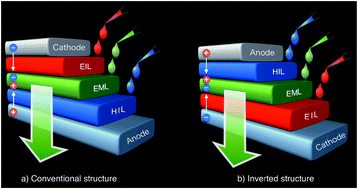Solution-processable electron injection materials for organic light-emitting devices
Abstract
Solution-processed organic light-emitting devices (OLEDs) have progressed as potential candidates for cost-effective solid-state lighting and flat panel displays. In this highlight, we focus on the recent progress of the state-of-the-art solution-processable electron injection materials: (i) alkali metal-containing compounds, (ii) n-type semiconducting metal oxides, (iii) π-conjugated ionic polymers, and (iv) nonionic polymers. These materials are soluble in water, alcohol, or a water–alcohol mixture solvent and can be formed into a film by a solution process. We discuss the essential characteristics of these electron injection materials and the performance of the solution-processed OLEDs made using them.


 Please wait while we load your content...
Please wait while we load your content...